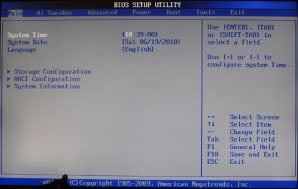Asus LGA1156 P7P55D-E Pro Motherboard Review
BIOS Options & MemOk!


The P7P55D-E Pro's BIOS options are straightforward and solid, much like the board itself. The main BIOS page is quite simple—AHCI options for the main Intel chipset are set under "Storage Configuration," AHCI configuration option info isn't actually useful until AHCI is enabled and the system is rebooted. BIOS version data and a few basic system details are given under "System Information."


The top and bottom of the AI Tweaker page are shown above. From here, it's possible to tell the motherboard to overclock the CPU automatically, or even to auto-tune the board for best performance. Various frequency and multiplier settings are also accessed here. The most interesting option is the "Asus/3rd Party UI Priority," which asks the end-user if they prefer to allow Asus' own software to control Windows-level overclocking, or if a third party utility is in use. If this option is set to "Asus Utility," the Asus program is given priority in the event of a settings conflict.




The last two pages of interest are the "Advanced" tab and the Hardware Monitor (located in the "Power" tab). The Advanced page allows the end user additional control over CPU settings that the majority of users will want to leave alone. Over on the right, there's Asus combination thermal monitor and Q-Fan option for controlling fan speeds. Fans can be left at default speeds or controlled according to user preferences.
Asus MemOk!:
The P7P55D-E Pro's manual describes MemOk! as follows:
Asus MemOk!:
The P7P55D-E Pro's manual describes MemOk! as follows:
MemOk! is the fastest memory booting solution today. This remarkable memory rescue tool requires nothing but a push of a button to patch memory issues and get your system up and running in no time. This technology is able to determine failsafe settings that can dramatically improve your system booting success.
That's an interesting claim and a potentially useful feature. Memory compatibility is nowhere near as problematic as it used to be, but issues can still crop up from time to time. Buyers who jumped on the P35+DDR3 wagon train back in 2007 and paid top-dollar for the privilege are ironically the group most likely to have problems today. Asus has published a video demonstrating how MemOk! resolves compatibility problems as linked below.
We set out to determine whether or not MemOk! made a difference when mixing various kinds of DDR3, but were unable to create a boot failure in the first place. Even when stuffed with a mixed set of 1GB and 2GB DIMMs with different SPD settings and built by four different manufacturers, the motherboard booted into Windows without a hiccup. This is, of course, exactly what we want the motherboard to do, but we were hoping to find a scenario that allowed us to test MemOk's ability to resolve RAM incompatibilities. Absent of this, we can't comment on MemOk! one way or the other. If you're partial to Asus and have some old DDR3 it's a feature you might want on a new board, but we can't guarantee it'll make a difference, either.
We set out to determine whether or not MemOk! made a difference when mixing various kinds of DDR3, but were unable to create a boot failure in the first place. Even when stuffed with a mixed set of 1GB and 2GB DIMMs with different SPD settings and built by four different manufacturers, the motherboard booted into Windows without a hiccup. This is, of course, exactly what we want the motherboard to do, but we were hoping to find a scenario that allowed us to test MemOk's ability to resolve RAM incompatibilities. Absent of this, we can't comment on MemOk! one way or the other. If you're partial to Asus and have some old DDR3 it's a feature you might want on a new board, but we can't guarantee it'll make a difference, either.






